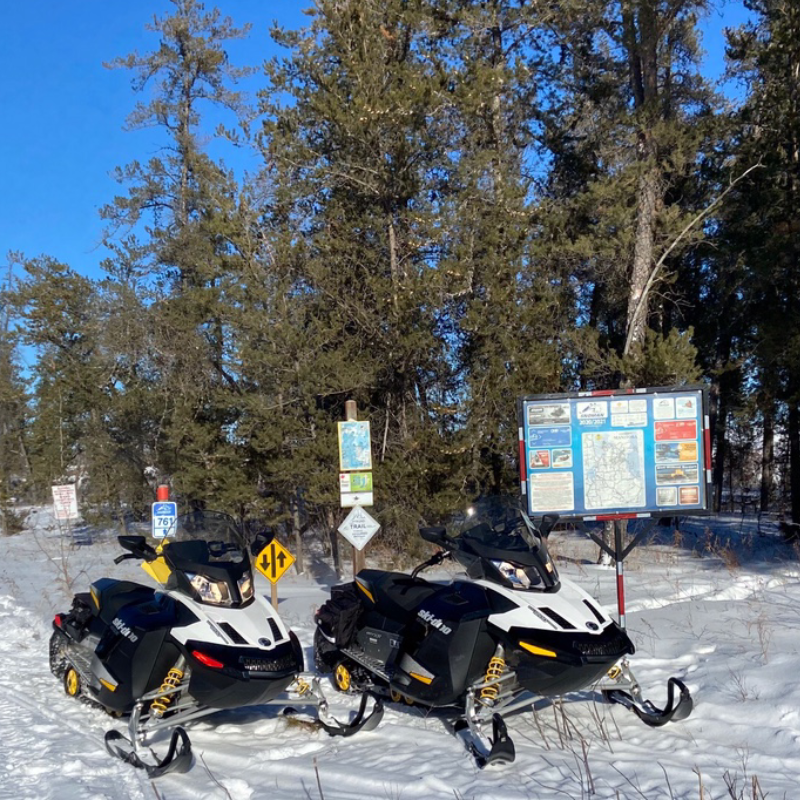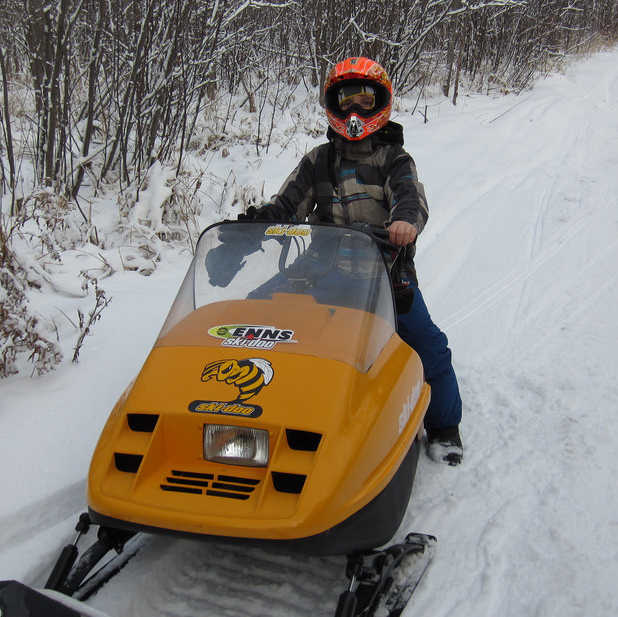Eastern Manitoba is known for its premier snowmobiling conditions. Sledders can ride hundreds of kilometres of trails, particularly when using Lac du Bonnet as their starting point. Trails head north, south, east and west from this community, and many of the trails are well groomed with warm-up huts along the way. The routes interconnect between the regions of four snowmobile clubs: the Lee River Snow Riders, Nopiming Sno-Mads, Eastman SnowPals and Mooswa Lake Snow Riders. The trails also connect with the larger provincial network of trails.
There are three main trails that run through Lac du Bonnet: the Riverland Trail to the east, which runs across the Winnipeg River to the Lee River trails; the Rail Bed Trail that goes southwest to Seddons Corner; and the Red Deer Trail that travels northwest to Powerview-Pine Falls. These trails can be accessed from nearly any point and all connect to several other trails surrounding Lac du Bonnet. They are open to everyone, but all riders must ensure they have a current Snopass; Snopasses are available through all Manitoba public insurance brokers.
The 24-hour rescue adventure in Lac du Bonnet
It was December 23, and a relatively balmy day on the trails just northeast of Lac du Bonnet. With the mercury sitting at -10 C, plenty of good snow on the ground and four friends who were keen to ride, it was the perfect afternoon for snowmobiling.
Barry Gesell, one of the four, said the group’s intent was to go out and ride for about an hour and a half, and just enjoy the trails and the outdoors. But what was meant to be a casual ride turned into a real-life adventure, complete with stuck snow machines, a long walk and a helicopter rescue. In fact, the story has nearly become legend in Lac du Bonnet, and Gesell has heard it circulate among other riders he doesn’t even know.
“It happened right at the beginning of the (snowmobile), year so we kept hearing it from other people, and it kept getting embellished,” said Gesell.
So if you’re not from Lac du Bonnet, or even if you are, here’s the real-life account of Gesell’s 90-minute outing that turned into a 24-hour adventure.
It was just two days before Christmas when Gesell and his friend Grant decided to meet up with some friends and go for a ride on their snowmobiles. They hit the trails—trails that weren’t quite open but that they’d been on before. After riding to the first warm-up shack, the foursome split; two friends headed home, leaving Gesell and Grant to carry on.
The two men were about 40 kilometres northeast of Lac du Bonnet when they ran into a problem.
“We were travelling across a swamp when Grant’s machine broke through and he went skipping across the water," said Gesell. "I was right behind him and did pretty much the same thing. We both got stuck."
And they both fell into the water, which thankfully was only chest deep.
The men tried to get their sleds out of the water, but after repeated attempts, decided to leave them and head towards the next warm-up shack, a two-kilometre walk away. They warmed up and waited for someone to drop by, but after two hours and no new faces, they decided to walk—wet clothes and all—to get help.
“We looked at a map and we thought we were about seven kilometres away from civilization,” said Gesell with a laugh. “We decided to start walking and when we got to the fork in the road, we realized we had another seven kilometres to go.”
It took them three hours to get to the first cottage. Luckily for them, someone was home. Gesell called his wife and then his friend Frank, who came and picked them up. On the way home, they stopped at a friend’s who just happened to own a helicopter company. After a call was dispatched for an early-morning rescue of the snowmobiles, Gesell and his friend headed home—it was 12:30 a.m.
The next morning, Gesell and his sledding buddy went out to the helicopter hangar. They joined the crew, then flew out to where the sleds were now frozen into the ice.
“The helicopter couldn’t land on the ice because the ice had already been broken," said Gesell, "so we had to jump from the helicopter onto the ice while it was hovering.”
It took a lot of effort, but the two men finally broke the ice and managed to free their machines from the swamp. Then, one at a time, the helicopter lifted each machine; the men hooked the sleds to a sling so they wouldn’t spin while in the air. The helicopter took one sled and then the other back to Gesell’s house—by then it was 1 p.m. Using his quad, Gesell moved his snowmobile into his garage then towed the other to his friend's house. On his way home the unthinkable happened—again. Gesell ran out of gas. He chuckles about it now, but he said at the time he wasn’t laughing.
Looking back at the whole ordeal, Gesell said there hadn’t been many options.
“I guess we could have walked away (from the sleds) completely,” said Gesell, “but we were never in any danger.”
He shrugs it off and chalks it up as an experience.
“It was just another day out travelling in the wilderness,” he said.





